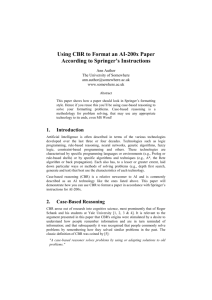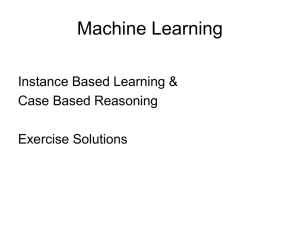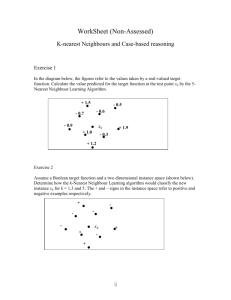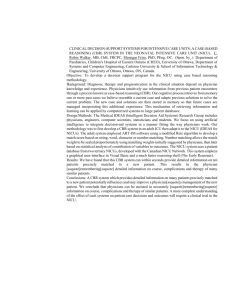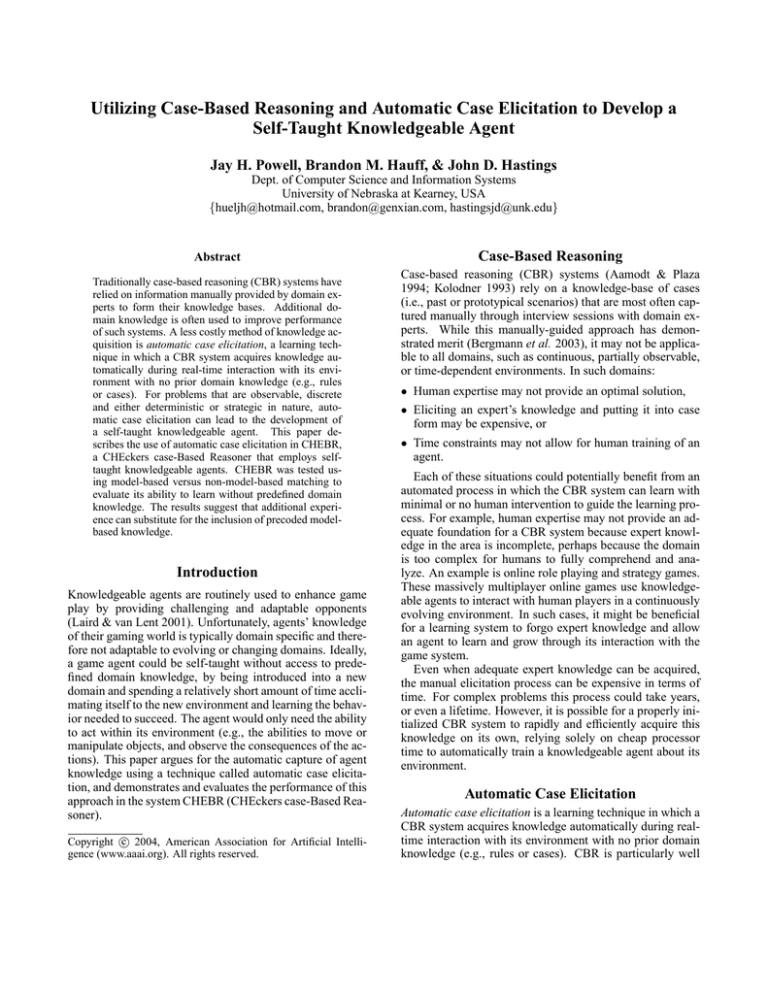
Utilizing Case-Based Reasoning and Automatic Case Elicitation to Develop a
Self-Taught Knowledgeable Agent
Jay H. Powell, Brandon M. Hauff, & John D. Hastings
Dept. of Computer Science and Information Systems
University of Nebraska at Kearney, USA
{hueljh@hotmail.com, brandon@genxian.com, hastingsjd@unk.edu}
Abstract
Traditionally case-based reasoning (CBR) systems have
relied on information manually provided by domain experts to form their knowledge bases. Additional domain knowledge is often used to improve performance
of such systems. A less costly method of knowledge acquisition is automatic case elicitation, a learning technique in which a CBR system acquires knowledge automatically during real-time interaction with its environment with no prior domain knowledge (e.g., rules
or cases). For problems that are observable, discrete
and either deterministic or strategic in nature, automatic case elicitation can lead to the development of
a self-taught knowledgeable agent. This paper describes the use of automatic case elicitation in CHEBR,
a CHEckers case-Based Reasoner that employs selftaught knowledgeable agents. CHEBR was tested using model-based versus non-model-based matching to
evaluate its ability to learn without predefined domain
knowledge. The results suggest that additional experience can substitute for the inclusion of precoded modelbased knowledge.
Introduction
Knowledgeable agents are routinely used to enhance game
play by providing challenging and adaptable opponents
(Laird & van Lent 2001). Unfortunately, agents’ knowledge
of their gaming world is typically domain specific and therefore not adaptable to evolving or changing domains. Ideally,
a game agent could be self-taught without access to predefined domain knowledge, by being introduced into a new
domain and spending a relatively short amount of time acclimating itself to the new environment and learning the behavior needed to succeed. The agent would only need the ability
to act within its environment (e.g., the abilities to move or
manipulate objects, and observe the consequences of the actions). This paper argues for the automatic capture of agent
knowledge using a technique called automatic case elicitation, and demonstrates and evaluates the performance of this
approach in the system CHEBR (CHEckers case-Based Reasoner).
c 2004, American Association for Artificial IntelliCopyright gence (www.aaai.org). All rights reserved.
Case-Based Reasoning
Case-based reasoning (CBR) systems (Aamodt & Plaza
1994; Kolodner 1993) rely on a knowledge-base of cases
(i.e., past or prototypical scenarios) that are most often captured manually through interview sessions with domain experts. While this manually-guided approach has demonstrated merit (Bergmann et al. 2003), it may not be applicable to all domains, such as continuous, partially observable,
or time-dependent environments. In such domains:
• Human expertise may not provide an optimal solution,
• Eliciting an expert’s knowledge and putting it into case
form may be expensive, or
• Time constraints may not allow for human training of an
agent.
Each of these situations could potentially benefit from an
automated process in which the CBR system can learn with
minimal or no human intervention to guide the learning process. For example, human expertise may not provide an adequate foundation for a CBR system because expert knowledge in the area is incomplete, perhaps because the domain
is too complex for humans to fully comprehend and analyze. An example is online role playing and strategy games.
These massively multiplayer online games use knowledgeable agents to interact with human players in a continuously
evolving environment. In such cases, it might be beneficial
for a learning system to forgo expert knowledge and allow
an agent to learn and grow through its interaction with the
game system.
Even when adequate expert knowledge can be acquired,
the manual elicitation process can be expensive in terms of
time. For complex problems this process could take years,
or even a lifetime. However, it is possible for a properly initialized CBR system to rapidly and efficiently acquire this
knowledge on its own, relying solely on cheap processor
time to automatically train a knowledgeable agent about its
environment.
Automatic Case Elicitation
Automatic case elicitation is a learning technique in which a
CBR system acquires knowledge automatically during realtime interaction with its environment with no prior domain
knowledge (e.g., rules or cases). CBR is particularly well
suited to automated real-time learning due to its ability to
acquire experiences in the form of cases and rapidly recall
and apply these prior experiences to new situations. This
is especially true for domains in which knowledge is incomplete or doesn’t exist and is suggested as an alternate to brute
force search techniques which do not transfer easily to new
problem domains.
Our approach views a real-time environment as being
comprised of a sequence of situations. For each situation
encountered, the system takes a reasonable action by referring to prior experience, evaluates the outcome of the action,
and commits the experience to memory along with a rating
of the action. In a sense, the rating represents a memory of
the usefulness of the action in the given context.
The action taken depends on the relationship of the situation to prior experience. For a situation with a similar past
experience and a successful outcome (i.e., one with a good
rating), the system applies the action taken in the prior experience to the current situation. For a situation that is novel,
sufficiently distant from prior experience, or previously unsolved (i.e., the actions taken in previous experiences with
the situation resulted in poor outcomes), the system creates
and applies a new action (e.g., by selecting an action at random or by combining the actions of multiple successful experiences) which does not depend on prior knowledge of the
model. Action in novel or previously unsolved situations results in the addition of new cases to memory, while the reuse
of an existing case in the identical context results in an update to the case’s success rating.
Over time, the system begins to encounter situations
which are identical or similar to those previously seen. The
system learns continuously by evaluating the application of
retrieved cases to these new situations. Cases that provide
good results suggest further reuse, while cases that provide poor outcomes suggest that alternate, previously unattempted solutions are required in given situations.
Related Work
Prior work has researched the use of CBR in games. For example, MAYOR (Fasciano 1996) is a player of the simulation game SimCity and is based on a predefined understanding of an incomplete world model. A case-based planner
complements the world by using a library of plans manually
built prior to game play. In automatic case elicitation, cases
are gathered in real time and are used as the sole reasoning
mechanism.
(Goodman 1993; 1994) uses offline built decision-tree induction projectors to predict the outcome of various actions
during game play in Bilestoad. Automatic case elicitation
differs in that agents learn in real time and projection is not
coded as a separate step but is instead encapsulated within
individual case ratings.
Previous work has also investigated the use of automatic
case generation from predefined expert knowledge. For example, the planning system SHOP/CCBR (Mukkamalla &
Muñoz-Avila 2002) automatically acquires cases from manually entered project plans. A related approach has been
seen in chess games (Flinter & Keane 1995; Sinclair 1998)
which use CBR for chess play by automatically generating
case libraries from sets of preexisting grandmaster games.
(Shih 2001) integrates CBR and the idea of sequential dependency to learn bridge play from a set of existing games.
Automatic case elicitation does not compile cases from manually entered or existing data, but instead knowledge is acquired automatically through the experiences of the agents
who learn completely from scratch.
GINA (DeJong & Shultz 1988) uses real-time experiencebased learning to enhance the abilities of an existing Othello
game-playing program. Automatic case elicitation differs in
that an existing problem solver is not used as a basis for the
system, instead CBR is used as the sole reasoning mechanism.
This research extends previous results by developing selftaught knowledgeable agents who learn in real time from
scratch by automatically acquiring knowledge in the form
of cases without the presence of preexisting model-based or
expert knowledge.
CHEBR
We illustrate automatic case elicitation in CHEBR, a CBR
system capable of allowing human and computer players to
compete in the board game of checkers. Checkers was chosen as an initial test domain due its observable, real-time
nature and its relative complexity due to the nondeterministic nature of the board (i.e., a specific board configuration is
not mapped directly to a corresponding correct action). In
CHEBR, computer players are represented by CBR agents
that utilize automatic case elicitation and play against other
computer and human players in order to learn and test their
expertise.
At the beginning of a CHEBR agent’s life, its only understanding of the checkers domain is a vision of the game
board and the ability to move game pieces. Since the agent
in its infancy has no prior experience with checkers, and
thus lacks knowledge of valid game play, it learns valid
moves through a process of trial-and-error interaction with
the game manager (a module that processes agent requests
and indicates whether or not the desired action is valid). This
approach is used rather than implementing a move generation technique that would depend on prior knowledge of the
domain. The agent repeatedly attempts a new move (i.e.,
one not previously seen in the case base) until a valid move
is found. Once found, the valid move is made and committed to the case base along with a snapshot of a real-time
board state and a rating of the move’s performance. As the
case library grows, the agent increasingly applies previously
acquired knowledge (in the form of cases) to new scenarios.
The rules and behavior which influence how the pieces are
controlled are not manually coded into the system, but rather
are acquired as an inherent part of the case library through
interaction with its environment.
A case rating system is used to provide positive reinforcement so that the agent can discriminate between appropriate
and inappropriate moves. The rating system uses the equation
c + W ins
2 × c + W ins + Losses
where c is a constant value used to deemphasize moves made
early on in an agent’s life when the agent is simply learning valid game play. For example, if the value of c is ten,
then for the first ten games the rating of every case in the
agent’s library will tend towards 0.5, the rating of an average move. As the agent gains more experience and plays
more games, the rating of a move can tend towards 1.0 (an
optimal move) or 0.0 (a completely ineffectual move). This
rating approach is meant to simulate a general positive remembrance a player might have for a particular move and
the general long-term consequences derived from repeated
application of said move.
The agent makes informed decisions (i.e. those based on
previous experience) by retrieving similar cases its case library as described in the following section. The retrieved
cases are sorted in descending order by their rating. The
agent attempts to apply the highest rated move by iterating
through the set of retrieved cases until a valid move is found.
If the agent finds that none of the moves from the retrieved
cases are applicable to the current board state, it resorts to
attempting a new move.
function FindRegionalMatchingCases()
1
C := case library
2
B := current game board
3
M := φ
4
for each case Ci C do
5
p0 := original position of piece moved in Ci
6
rc0 := RegionCenteredAt(Ci , p0 )
7
rb0 := RegionCenteredAt(B, p0 )
8
pf := final position of piece moved in Ci
9
rc1 := RegionCenteredAt(Ci , pf )
10
rb1 := RegionCenteredAt(B, pf )
17
avgDif f :=
Matching in CHEBR
18
avgRegionSize :=
Two different matching algorithms were tested in CHEBR.
The first algorithm, called CHEBR-Exact, requires retrieved
cases to exactly match the current board. We will not detail
CHEBR-Exact, but note that multiple cases can be retrieved
because a variety of moves can typically be made for any
one board position.
The second algorithm, called CHEBR-Region, uses a
regional matching scheme (similar to chunking in chess
(Flinter & Keane 1995)) and is summarized in Figure 1
by the function FindRegionalMatchingCases. CHEBRRegion begins by reading a case (Ci ) from the agent’s
case library and extracting the original location of the piece
moved (p0 ) and the final position of the piece (pf ). The
agent then begins its examinations of the retrieved case and
the current board by constructing small grids (i.e., subsets
of both the case and checkers board) centered around p0
and pf on the case as well as the board using the function
RegionCenteredAt. Each grid contains the specified
center position (p0 or pf ) and all immediately adjacent locations. The purpose of these grids is to allow the agent to
investigate how game pieces close to it will affect the move
being made.
When grids are built, two scenarios can occur. The first
scenario takes place when grids surrounding the original and
final locations of the piece in the case overlap (rc0 ∩ rc1 6=
φ), meaning that the move made in the case was a relatively
short one (i.e., not a multiple jump), and regions surrounding intermediate jump steps need not be considered when
comparing the case to the current board.
The second scenario arises when the grids constructed by
the agent do not overlap (rc0 ∩ rc1 = φ), meaning that the
move made in the case was a long one (i.e., a multiple jump).
In this situation, regions with an offset of ±δ from the midpoint (pm ) of the multiple jump in both the case and current
board are compared. These regions allow a better comparison of game pieces in the area that the agent may move
11
12
13
14
15
16
19
20
21
if (rc0 ∩ rc1 ) = φ then
|p −p |
pm := 0 2 f
rc2 := RegionCenteredAt(Ci , pm − δ)
rb2 := RegionCenteredAt(B, pm − δ)
rc3 := RegionCenteredAt(Ci , pm + δ)
rb3 := RegionCenteredAt(B, pm + δ)
Pn−1
k=0
(rck −rbk )
n
Pn−1
k=0
card(rck )
n
if avgDif f < (α × avgRegionSize) then
M := M ∪ Ci
return M
;matching cases
Figure 1: CHEBR-Region matching algorithm
through. By examining the area surrounding the origin and
destination of the move, as well as the areas immediately adjacent to the midpoint of the move, a subset of the checkers
board that is roughly shaped like a diamond is examined.
Once analogous regions on both the case and current
board state have been constructed, they are compared to determine similarity. To do this, the average difference between corresponding regions is calculated, as well as the
average size of each of the regions. The average region
difference determines the number of pieces in each corresponding region that differ. If no more than α percent
of the pieces in the case and the current board state differ
(avgDif f < α × avgRegionSize ), then the case is considered to sufficiently match the current board state. The
algorithm proceeds in this manner and checks every case in
the library until all matching cases are found and returned.
Results
CHEBR was tested using the two matching algorithms described in the previous section to evaluate its ability to learn
without the use of predefined domain knowledge. The two
configurations, CHEBR-Exact and CHEBR-Region, each
with initially empty knowledge bases, were pitted against
one another for 2000 games (approximately two and onehalf hours worth of game time on a machine running an
AMD Athlon XP2000+ processor).
Figure 2 shows the winning percentage of the CHEBR-
Figure 2: Win/loss ratio for CHEBR-Exact and CHEBRRegion
Exact and CHEBR-Region agents during a 2000 game
match. These results were duplicated in repeated tests with
a slight variability caused by the use of random move generation. CHEBR-Exact plays without prior domain knowledge, while CHEBR-Region takes advantage of non-learned
precoded domain knowledge (i.e., a matching algorithm that
assumes that checkers players might gain a strategic advantage by looking at regions within a game board). Notice that
CHEBR-Region proved initially superior to CHEBR-Exact
but the initial wide difference in skill decreased over time
as CHEBR-Exact learned to adjust to the region matching
strategies used by CHEBR-Region. The results suggest that
experience gained through additional training (in CHEBRExact) can substitute for the addition of precoded modelbased knowledge (in CHEBR-Region).
until a spike within the last 100 games.
Although not demonstrated in the figures, CHEBRExact’s current checkers game play is competitive in the
early to mid portion of each game played. CHEBR-Exact’s
quality of moves late in the game, especially with a small
case library, deteriorates due to the great number of permutations of board configurations and a low ratio of these permutations represented in the case library. As CHEBR-Exact
is trained longer and allowed to expand its case base, checker
game play improves. These results are consistent with previous results (Sinclair 1998) that argue that larger case bases
are required to fully represent diverse scenarios which are
commonly encountered towards the end of game play.
Overfitting is a natural concern when training CBR systems for a long time. The results in Figure 2 do not seem
to illustrate a convergence that could be caused by an overtraining effect in which an agent learns to repeatedly apply
a small set of effective moves against a particular opponent.
Note, however, the spike in the case-use ratio for CHEBRExact in Figure 3 within the last 100 games. This spike
suggests either overtraining or that CHEBR-Exact is quickly
finding a technique for winning against CHEBR-Region.
It appears that CHEBR-Exact requires more games of
training to effectively learn checkers play. It is further
believed that if CHEBR-Exact were allowed to compete
against multiple opponents in the initial stages of its training, CHEBR-Exact might be better able to learn different
game play strategies employed by a variety of opponents.
This could be accomplished by allowing an inexperienced
CHEBR-Exact agent to compete against a set of other computer players, each capable of utilizing their own distinct
stratagems.
Conclusion
Figure 3: Case-use ratio for CHEBR-Exact and CHEBRRegion
Figure 3 illustrates the percentage of situations in which
CHEBR-Exact and CHEBR-Region were able to reuse cases
from their case library. The figure, which uses a sixth degree
polynomial trend line to smooth the case ratio graph, shows
that CHEBR-Region initially depended on prior experience
around eighty percent of the time, with the ratio steadily decreasing throughout the testing. This means that over time
CHEBR-Region was less able to apply previous experience
to new situations. The early high case-use ratio for CHEBRRegion suggests that it is often incorrectly applying prior experiences, perhaps due to an overly general region matching
scheme. As expected, CHEBR-Exact’s case-use ratio grew
at a much slower rate due to its requirement for exact case
matches, but this rate grew for the majority of the training
The development of knowledgeable agents is an interesting
subset of artificial intelligence. CBR is one approach to developing such agents. Unfortunately, most CBR systems
rely upon previously and manually gathered expert knowledge. An alternate approach, automatic case elicitation, represents a less costly learning technique (for acquiring agent
knowledge) in which a CBR system acquires knowledge automatically during real-time interaction with its environment
with no prior domain knowledge (e.g., rules or cases). For
problems that are observable, discrete and either deterministic or strategic in nature, automatic case elicitation can lead
to the development of a self-taught knowledgeable agent.
Automatic case elicitation is demonstrated within CHEBR,
a CHEckers case-Based Reasoner that employs self-taught
knowledgeable agents. CHEBR was tested using modelbased versus non-model-based matching to evaluate its ability to learn without predefined domain knowledge. The results suggest that additional experience can substitute for the
inclusion of precoded model-based knowledge.
Future Work
In the future, we hope to apply automatic case elicitation to
massively multiplayer online games. In the meantime, we
hope to learn more about automatic case elicitation within
the context of CHEBR. We are currently looking at a variation of CHEBR-Exact that uses a k-nearest neighbor approach instead of exact matches. In addition, we plan to improve the move rating system used by CHEBR. Moves made
early in training, when an agent is simply learning valid
game play, are weighted equally with moves made in later
games when actions are more informed. Early moves, which
are based on little experience, tend to be low in quality and
skew the case rating downward, eventually causing moves
made in early games to be used less frequently. The case
rating strategy will be revised to emphasize actions taken
later in training.
We are developing more advanced model-based versions
of CHEBR in order to provide a more rigorous test of
CHEBR-Exact. Model-based refinements include improved
model-based matching, and a model-based rating system
that will select moves based on multiple goals including the
current long-term goal of winning a game as well as shortterm goals such as minimizing the number of pieces lost as
the result of a single move.
Acknowledgements
Thanks to Matt Culver and Nolan Jurgens for their help in
the initial development of CHEBR.
References
Aamodt, A., and Plaza, E. 1994. Case-based reasoning:
Foundational issues, methodological variations, and system approaches. AI Communications 7(1):39–59.
Bergmann, R.; Althoff, K.-D.; Breen, S.; Göker, M.; Manago, M.; Traphöner, R.; and Wess, S. 2003. Developing Industrial Case-based Reasoning Applications: The INRECA
Methodology. Number 1612 in Lecture Notes in Artificial
Intelligence. Springer Verlag, 2nd edition.
DeJong, K. A., and Shultz, A. C. 1988. Using experiencebased learning in game-playing. In Proceedings of the Fifth
International Conference on Machine Learning, 284–290.
San Mateo, California: Morgan Kaufmann.
Fasciano, M. J. 1996. Real-time case-based reasoning in
a complex world. Technical Report TR-96-05, Computer
Science Department, University of Chicago.
Flinter, S., and Keane, M. T. 1995. On the automatic
generation of case libraries by chunking chess games.
In Proceedings of the First International Conference on
Case Based Reasoning (ICCBR-95), LNAI 1010, 421–430.
Springer Verlag.
Goodman, M. 1993. Projective visualization: Acting from
experience. In Proceedings of the Eleventh National Conference on Artificial Intelligence (AAAI-93), 54–59. Menlo
Park, Calif.: AAAI Press.
Goodman, M. 1994. Results on controlling action with
projective visualization. In Proceedings of the Twelfth
National Conference on Artificial Intelligence (AAAI-94),
1245–1250. Menlo Park, Calif.: AAAI Press.
Kolodner, J. 1993. Case-based reasoning. San Mateo,
Calif.: Morgan Kaufmann.
Laird, J. E., and van Lent, M. 2001. Human-level ai’s killer
application: Interactive computer games. In AI Magazine,
volume 2, 15–26. AAAI Press / The MIT Press.
Mukkamalla, S., and Muñoz-Avila, H. 2002. Case acquisition in a project planning environment. In Proceedings of
the Sixth European Conference on Case-based Reasoning
(ECCBR-02), LNAI 2416, 264–277. Springer-Verlag.
Shih, J. 2001. Sequential instance-based learning for
planning in the context of an imperfect information game.
In Proceedings of the Fourth International Conference on
Case-Based Reasoning (ICCBR-01), LNAI 2080, 483–501.
Springer-Verlag.
Sinclair, D. 1998. Using example-based reasoning for selective move generation in two player adversarial games.
In Proceedings of the Fourth European Workshop on CaseBased Reasoning (EWCBR-98), LNAI 1488, 126–135.
Springer-Verlag.



